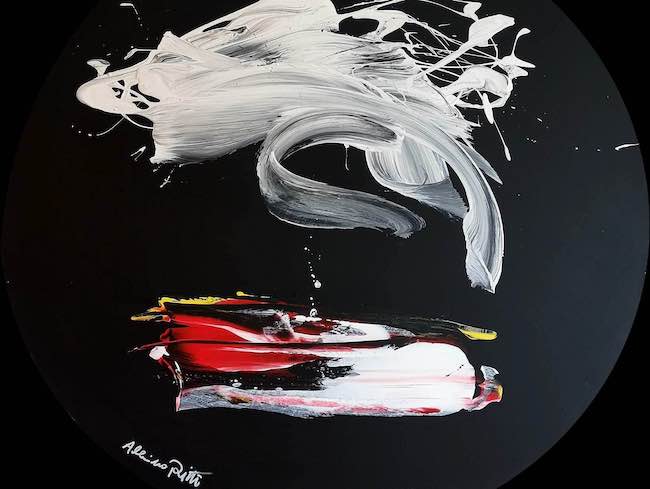Laddove esistono artisti che hanno bisogno della riflessione, della contemplazione della realtà e della possibilità di meditare le emozioni di cui narrare nelle proprie opere, ne esistono altri che al contrario vivono la manifestazione creativa come una vera e propria liberazione istintiva, primordiale, perché è esattamente nel gesto plastico con la sua purezza che riescono a liberare quel mondo emozionale, le sensazioni appartenenti all’interiorità e che hanno bisogno di fuoriuscire attraverso l’irruenza del caos. L’artista di cui vi racconterò oggi vive l’atto creativo nella sua completezza, trasformando il momento del contatto con la tela in un’esperienza in cui la prima protagonista è proprio l’azione.
Intorno alla metà degli anni Cinquanta del Novecento un nutrito gruppo di artisti si unì per dare vita a un movimento le cui linee guida principali erano la libertà espressiva, dunque senza regole stilistiche che avrebbero solo imprigionato i creativi di schemi ben definiti che nessuno più voleva, e la necessità di comunicare emozioni, tirandole fuori nella modalità maggiormente affine alle caratteristiche espressive di ciascun autore dell’opera. L’Espressionismo Astratto, questo il nome del rivoluzionario gruppo, accolse artisti differenti tra loro, spesso persino apparentemente opposti e divergenti purché conformi allo scopo primario dell’intento creativo, quello cioè di essere manifestazione del mondo interiore dell’esecutore; ecco perché l’impeto irruento di Jackson Pollock poteva coabitare con l’immobilità della monocromia di Barnett Newman, e la liricità astratta di Arshile Gorky tendeva la mano alle atmosfere suggestive e meditative di Mark Rothko tanto quanto alle dinamiche linee variopinte di Morris Louis. Malgrado il rifiuto da parte del mondo culturale e della critica dell’epoca – l’Espressionismo Astratto fu rifiutato dal direttore del Moma in occasione della grande mostra sulle avanguardie americane suscitando la forte reazione degli appartenenti al gruppo che a seguito di una lettera di protesta inviata al New York Times furono definiti Irascibili – gli artisti appartenenti a questo movimento stravolsero l’approccio all’Arte Astratta che fino a quel momento era legata all’oggettività, completamente distaccata dal soggetto esecutore e fine a se stessa, quasi un’analisi scientifica del gesto plastico, e non solo portarono in primo piano l’importanza del mondo interiore ed emozionale ma oltrepassarono la bidimensionalità della tela per introdurre l’azione come imprescindibile parte del processo creativo. L’Action Painting, che poteva manifestarsi con il Dripping di Jackson Pollock, con il Color Field di Helen Frankenthaler, con il segno di Franz Kline, con il Tachisme di Hans Hofmann, costituiva di fatto una simbiosi tra esecutore, tela, colori e gesto, inteso come espressione di un impulso pittorico che non doveva subire il filtro della ragione e che aveva bisogno di fuoriuscire in maniera spontanea e libera; l’atto stesso del dipingere diveniva dunque un momento d’arte, un frangente in cui l’opera diveniva il principio, il mezzo e anche il fine, evidenziando e mettendo in luce l’importanza dell’azione. La medesima intenzione espressiva emerge nelle opere di Albino Pitti, permettendogli di strutturare e concretizzare il suo personale linguaggio pittorico in cui il movimento, inteso come gesto esecutivo, diviene parte stessa di ciascuna delle sue tele che raccontano frammenti di emozioni e di sensazioni accordandosi allo stato d’animo artista.
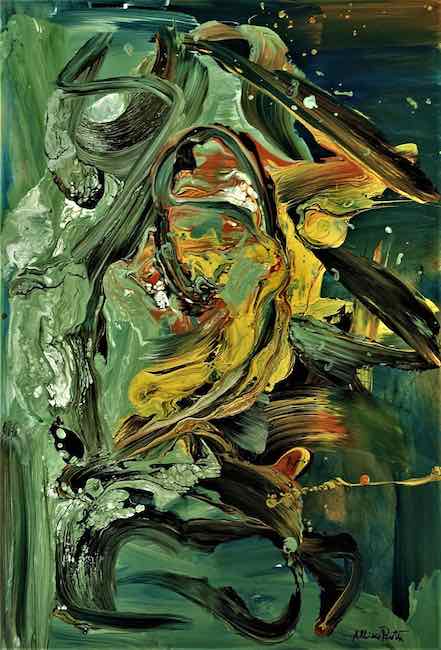
Il suo lungo cammino nel mondo dell’arte del Novecento lo ha visto protagonista nonché esponente dell’arte italiana in tutto il mondo e cofondatore dei gruppi dell’Espansionismo, del Transvisionismo e del G.A.D ed è stato in virtù anche di queste esperienze che ha sperimentato e strutturato un particolare stile che mostra le sfaccettature della realtà osservata, delle molteplici interpretazioni di tutto ciò che accade e struttura il processo di conoscenza proprio attraverso l’istintualità, come se nel movimento dall’interno del suo sentire all’esterno del colore che tende verso la tela, si compisse la consapevolezza, la presa d’atto della consistenza delle emozioni.
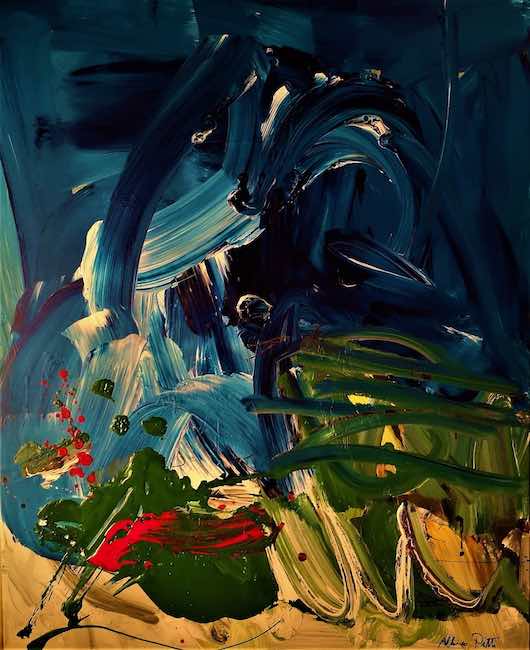
La stesura delle tonalità scelte è pertanto densa, non modulata né stemperata bensì assecondata all’intensità del sentire, alla connessione con una profondità che preme per fuoriuscire con urgenza per non dimenticare quel frammento emozionale, lasciando un’impronta consistente, quasi come se quelle tracce cromatiche dovessero incrociarsi anche nel mondo materiale per dare un senso più concreto a tutto ciò che diversamente sfuggirebbe. Non solo, nelle sue tele si percepisce prevalentemente quel processo di esternazione, quel propagarsi dal buio della profondità e dell’inconsapevolezza emotiva, contraddistinta dal nero, dal verde e dal blu scuri, per poi arrivare alla rivelazione del contenuto di quello slancio, un chiarore, un lampo di intuizione che attraverso la tela diviene nozione, esperienza; l’atto pittorico per Albino Pitti è quindi una parte essenziale della realizzazione di un dipinto, l’azione si lega imprescindibilmente all’esecuzione e al risultato finale, senza soluzione di continuità. Comunicare significa esplorare il proprio sé, guidarlo per raggiungere un’evoluzione superiore, quella in cui la mente, prevalentemente limitata e limitante, lascia spazio all’istinto, all’emozione in grado di aprire l’animo alla conoscenza, all’elevazione verso un percorso più consapevole, più centrato e capace di infondere certezze che non provengono dall’esterno bensì dalla connessione tra l’altro da sé e quel mondo sotterraneo che tutto comprende.
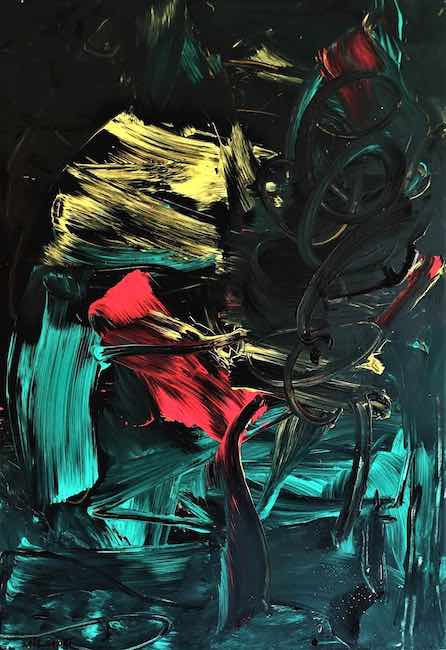
Il dipinto Sogno al Mar Nero inizia proprio dal buio della coscienza, dallo sguardo distratto che sembra contraddistinguere l’uomo contemporaneo e che non gli consente di apprezzare ciò che lo circonda; tuttavia Albino Pitti lascia emergere i colori, quelli osservabili a una seconda occhiata in virtù della quale comincia a delinearsi una luce, una presa d’atto della bellezza, dell’emozione che vibra oltre la razionalità e che non può fare a meno di travolgere l’individuo. Da quel turbamento l’artista si lascia conquistare, gli si abbandona, e poi lascia vagare lo sguardo sui colori predominanti che quindi si manifestano sulla tela, la squarciano con la loro materialità, la illuminano con le sensazioni che si propagano fino quasi a far dimenticare il buio dei contorni dell’opera.

Nel dipinto In terra etrusca Albino Pitti evoca non solo i colori tipici di un luogo ormai sospeso tra il glorioso passato di una popolazione estinta e la memoria di sé che essa ha lasciato attraverso utensili, suppellettili e costruzioni sotterranee in cui sono conservati i loro tesori, bensì anche la capacità artigianale, quella tendenza a costruire oggetti di uso comune, più o meno preziosi, che hanno avuto la capacità di attraversare i secoli, di mantenersi intatti; è per questo che aggiunge la materia, dunque non più solo la densità della pennellata, per omaggiare l’abilità creativa e artigianale di una grande civiltà in cui il rispetto e i valori importanti erano guida stessa della civiltà. Gli ocra, i bianchi e i neri richiamano alla memoria le terre dell’alto Lazio e della bassa Toscana, dove gli etruschi hanno costruito i loro villaggi e vissuto la loro vita.
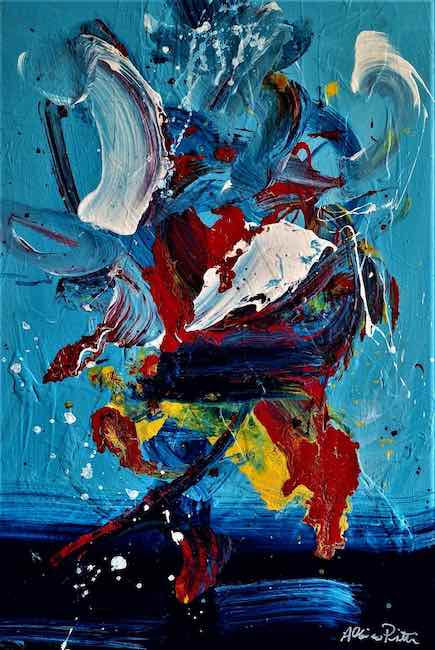
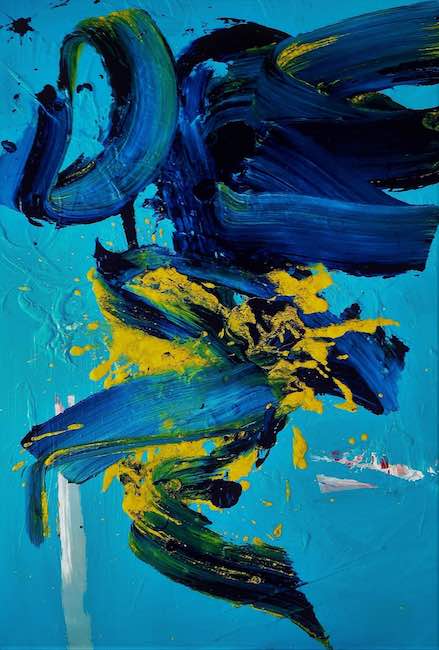
In altre opere come Parea e Tanaica invece, Pitti sembra mostrare un approccio più aperto, più sereno, quasi come se i momenti precedenti, quelli in cui l’ombra e l’oscurità prevalgono, dovessero lasciare spazio a un’osservazione differente, più orientata a percepire i veri colori, la positività che fuoriesce quasi come contrappeso al suo opposto perché in fondo, sembra suggerire Albino Pitti, il buio, le nuvole non permangono mai troppo a lungo. Pertanto l’Espansionismo diviene un invito alla conoscenza di sé, all’apprendimento di tutto ciò che accade, si verifica, si manifesta, per raggiungere un livello più alto in virtù del quale si accetta l’alternanza tra positivo e negativo e si apprende a non lasciarsi abbattere dagli accadimenti; perché il dopo sarà maggiormente chiaro, variopinto, allegro e solo chi ha attraversato il buio riuscirà a vederne l’intensità, solo chi ha compreso quanto sia importante addentrarsi nelle profondità del sentire, anche quelle meno piacevoli, sarà in grado di respirare a pieni polmoni, di scorgere e apprezzare la forza dei colori che circondano la vita.
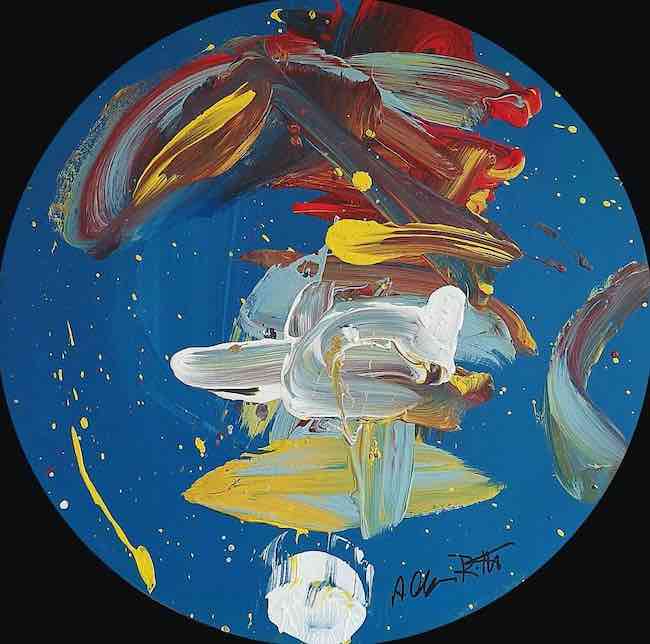
Ciò a cui Albino Pitti non rinuncia è quell’approccio esperienziale nei confronti di qualunque sua tela, ogni volta differente perché niente è uguale a se stesso, neanche le emozioni, in accordo con il concetto eracliteo del Pantha rei secondo cui non sarà mai possibile bagnarsi nella stessa acqua, così come secondo Pitti, non sarà mai possibile provare le medesime sensazioni benché di fronte al medesimo evento. Albino Pitti ha esposto a New York, Dallas, Philadelphia. Espone a Parigi, Milano, Nizza, Francoforte, Madrid, Sofia, ha avuto per alcuni anni opere in permanenza presso l’Espai Miquel Gaspar, Galeria Antoni Pinyol, Museu d’Art Modern di Tarragona in Spagna, sotto la guida del direttore Lluis Montane, e ha collezionisti in tutto il mondo. Dal 2019 Albino Pitti è supportato da Art Finance Fund, un fondo d’investimento specializzato nella valorizzazione di opere d’arte, all’interno del settore dedicato agli artisti con potenzialità di affermazione sul mercato internazionale.
ALBINO PITTI-CONTATTI
Email: albinopitti756@gmail.com
Sito web: https://albinopittiart.wordpress.com/
Facebook: https://www.facebook.com/profile.php?id=100074409036756
Instagram: https://www.instagram.com/contemporary_art_pitti/
The Abstract Expressionism of Albino Pitti, when space and time join in the pictorial gesture
Wherever there are artists who need reflection, contemplation of reality and the possibility of meditating on the emotions to be narrated in their artworks, there are others who, on the contrary, live the creative manifestation as a true instinctive, primordial liberation, because it is precisely in the plastic gesture with its purity that they are able to release that emotional world, the sensations belonging to the interiority and that need to escape through the impetuosity of chaos. The artist I am going to tell you about today lives the creative act in its entirety, transforming the moment of contact with the canvas into an experience in which the first protagonist is precisely the action.
Around the mid-1950s, a large group of artists came together to give life to a movement whose main guidelines were freedom of expression, i.e. without stylistic rules that would only imprison the creators in well-defined schemes that no one wanted any more, and the need to communicate emotions, drawing them out in the manner most akin to the expressive characteristics of each author of the work. Abstract Expressionism, this is the name of the revolutionary group, welcomed different artists, often even apparently opposing and divergent, as long as they conformed to the primary purpose of the creative intent, that of being a manifestation of the performer’s inner world; that is why the impetuous rush of Jackson Pollock could cohabit with the stillness of Barnett Newman’s monochrome, and the abstract lyricism of Arshile Gorky tended to the suggestive and meditative atmospheres of Mark Rothko as much as to the dynamic multi-coloured lines of Morris Louis. Despite the rejection by the cultural world and critics of the time – Abstract Expressionism was rejected by the director of the MOMA on the occasion of the great exhibition on the American avant-garde, provoking a strong reaction from the members of the group who, following a letter of protest sent to the New York Times, were called Irascibles – the artists belonging to this movement overturned the approach to Abstract Art that until then had been linked to objectivity, completely detached from the subject performer and an end in itself, almost a scientific analysis of the plastic gesture, and not only brought to the forefront the importance of the inner and emotional world but went beyond the two-dimensionality of the canvas to introduce action as an indispensable part of the creative process.
Action Painting, which could manifest itself with Jackson Pollock’s Dripping, Helen Frankenthaler’s Colour Field, Franz Kline’s Sign, Hans Hofmann’s Tachisme, was in fact a symbiosis between performer, canvas, colours and gesture, intended as the expression of a pictorial impulse that did not have to undergo the filter of reason and that needed to come out spontaneously and freely; the very act of painting thus became a moment of art, a juncture in which the artwork became the beginning, the means and also the end, highlighting and emphasising the importance of the action. The same expressive intention emerges in Albino Pitti’s artworks, allowing him to structure and concretise his personal pictorial language in which movement, understood as an executive gesture, becomes an integral part of each of his canvases that tell fragments of emotions and sensations in tune with the artist’s state of mind. His long journey in the 20th century art world saw him as a protagonist and exponent of Italian art throughout the world and co-founder of the Expansionism, Transvisionism and G.A.D. groups and it was also by virtue of these experiences that he experimented and structured a particular style that shows the facets of the reality observed, of the multiple interpretations of everything that happens and structures the process of knowledge precisely through instinctuality, as if in the movement from the inside of his feeling to the outside of the colour tending towards the canvas, the awareness, the acknowledgement of the consistency of emotions is accomplished. The drafting of the tones chosen is therefore dense, neither modulated nor diluted, but rather gone along with the intensity of feeling, to the connection with a depth that presses urgently to come out so as not to forget that emotional fragment, leaving a consistent imprint, almost as if those chromatic traces should also cross over into the material world to give a more concrete sense to everything that would otherwise escape. Not only that, in his canvases one predominantly perceives that process of externisation, that propagation from the darkness of depth and emotional unawareness, marked by black, green and dark blue, to then arrive at the revelation of the content of that impetus, a glimmer, a flash of intuition that through the canvas becomes notion, experience; the act of painting for Albino Pitti is therefore an essential part of the realisation of a painting, the action is inseparably linked to the execution and the final result, without solution of continuity.
To communicate means to explore one’s own self, to guide it to reach a higher evolution, one in which the mind, predominantly limited and limiting, leaves room for instinct, for emotion able of opening the soul to knowledge, to elevation towards a more conscious path, more centred and capable of instilling certainties that do not come from the outside but from the connection between the other self and that subterranean world that encompasses everything. The painting Dream at the Black Sea starts precisely from the darkness of consciousness, from the distracted gaze that seems to characterise contemporary man and that does not allow him to appreciate what surrounds him; however, Albino Pitti allows colours to emerge, those observable at a second glance, by virtue of which a light begins to go out, an awareness of beauty, of the emotion that vibrates beyond rationality and that cannot help but overwhelm the individual. The artist allows himself to be conquered by that disturbance, he abandons himself to it, and later lets his gaze wander over the predominant colours that then manifest themselves on the canvas, piercing it with their materiality, illuminating it with sensations that spread out almost to the point of making one forget the darkness of the artwork’s contours. In the painting In Etruscan land, Albino Pitti evokes not only the typical colours of a place now suspended between the glorious past of an extinct population and the memory of itself that it has left through utensils, furnishings and underground constructions in which their treasures are preserved, but also the craftsmanship, that tendency to construct everyday objects, more or less precious, that have had the ability to cross the centuries, to remain intact; this is why he adds the material, hence not just the density of the brushstroke, to pay homage to the creative and craftsmanship skills of a great civilisation in which respect and important values were the very guide to civilisation.
The ochres, whites and blacks call to mind the lands of upper Lazio and lower Tuscany, where the Etruscans built their villages and lived their lives. In other paintings such as Parea and Tanaica, on the other hand, Pitti seems to show a more open, more serene approach, almost as if the previous moments, those in which shadow and darkness prevail, were to leave room for a different observation, more oriented towards perceiving true colours, the positivity that emerges almost as a counterbalance to its opposite because after all, Albino Pitti seems to suggest, darkness, clouds, never remain for too long. Therefore, Expansionism becomes an invitation to self-knowledge, to learn about everything that happens, occurs, manifests itself, in order to reach a higher level by virtue of which one accepts the alternation between positive and negative and learns not to let oneself be brought down by events; because the aftermath will be clearer, more colourful, more cheerful, and only those who have gone through the darkness will be able to see its intensity, only those who have understood how important it is to delve into the depths of feeling, even the less pleasant ones, will be able to breathe deeply, to perceive and appreciate the strength of the colours that surround life. What Albino Pitti does not renounce is that experiential approach to any of his canvases, each time different because nothing is the same, not even emotions, in accordance with the Heraclitean concept of the Pantha rei according to which it will never be possible to bathe in the same water, just as according to Pitti, it will never be possible to experience the same sensations even when faced with the same event. Albino Pitti has exhibited in New York, Dallas, Philadelphia. He exhibits in Paris, Milan, Nice, Frankfurt, Madrid, Sofia, has paintings on permanent display at Espai Miquel Gaspar, Galeria Antoni Pinyol, Museu d’Art Modern in Tarragona, Spain, under the guidance of director Lluis Montane, and has collectors worldwide. Since 2019, Albino Pitti has been supported by Art Finance Fund, an investment fund specialised in the valorisation of artworks, within the sector dedicated to artists with potential for success on the international market.


